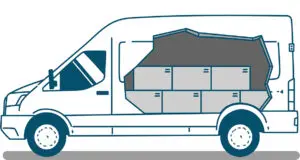Check what you know
Did you know?
Best practice tips
Check what you know
Did you know?
- The EU Parliament Road Safety Group reports that 86% of all rollover accidents involve driver error.
- The centre of gravity (CoG) for delivery vehicles will move due to the changing load.
- The higher the centre of gravity, the easier it is to overturn the vehicle.
- A slope of more than around 33% will usually cause a vehicle to rollover.
As a vehicle’s load decreases while making deliveries, the centre of gravity changes. The load may need to be adjusted to improve load stability and prevent it from shifting.
A fully loaded vehicle makes braking more difficult, increases stopping distance and time, and requires the driver to be more cautious when turning.
Best practice tips
The load in the van must be secure. Movement of the load can affect the centre of gravity of the vehicle, causing it to be less stable to drive and inceasing the risk of a rollover.
- Eliminate distractions and always pay attention to the road and how the vehicle is handling.
- Scan the road ahead looking for hazards and changing conditions.
- To alert other drivers of your presence, sound your horn when approaching tight rural road bends and anticipate oncoming traffic.
- Avoid sudden manoeuvres, over-steering, over-acceleration, and harsh braking.
- To help maintain full control and stability of the vehicle and load, reduce speed in poor weather conditions, and if the road has a lot of mud, gravel, or debris along its surface.
How a vehicle is loaded can significantly affect its handling on the road and the likelihood of the load moving or becoming unstable during the journey.
The centre of gravity of a loaded goods vehicle tends to be much higher than that of a passenger car. This makes a goods vehicle more likely to rollover than a car at the same speed.
Sharp corners, uneven road surfaces and ditches can increase the risk of a rollover. Drivers should stay alert and be prepared to adjust their driving to match the conditions.
Multi-drop deliveries can cause drivers issues with their responsibility for the safety and security of the load.
 Drivers must take an adequate amount of time necessary to use appropriate equipment to secure the load properly.
Drivers must take an adequate amount of time necessary to use appropriate equipment to secure the load properly.
Loads should be distributed between axles and the weight spread as evenly as possible, fully utilising the vehicle’s floor area.
Drivers should be wary about axle overloads and moving centres of gravity when removing large portions of the load from either the front or the rear of the vehicle loading area.
Categories


Crown Copyright 2025
You may re-use this information (not including logos) free of charge in any format or medium, under the terms of the Open Government Licence.
To view this licence, visit www.nationalarchives.gov.uk/doc/open-government-licence